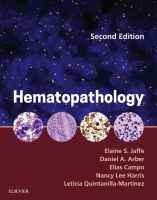Physical Address
304 North Cardinal St.
Dorchester Center, MA 02124

Cutaneous T-cell lymphomas (CTCLs) comprise, for the most part, mycosis fungoides (MF) and variants and cutaneous CD30 + lymphoproliferative disorders, but other rare subtypes may be the source of diagnostic and therapeutic challenges. Some of these rare lymphomas show overlapping…

Definition Three types of primary cutaneous CD30 + lymphoproliferative disorders (LPDs) are recognized in the World Health Organization classification: primary cutaneous anaplastic large cell lymphoma (C-ALCL), lymphomatoid papulosis (LyP), and borderline lesions. These entities represent a continuous spectrum of lesions…

Mycosis fungoides and Sézary syndrome are two closely related conditions in which neoplastic T cells infiltrate the skin and circulate in the peripheral blood. Both conditions are neoplasms that typically have a mature helper T-cell phenotype and a propensity to…

Enteropathy-Associated T-Cell Lymphoma (Type I, Classical) An association between malabsorption and intestinal lymphoma was first reported in 1937, at which time lymphoma was considered responsible for the malabsorption. However, in 1962, Gough and coworkers demonstrated that intestinal lymphoma was a…

Definition and Background Among the heterogeneous group of hematopoietic neoplasms with a predominant population of large cells, Stein and colleagues recognized a subgroup of tumors with large cells exhibiting bizarre morphologic features and prominent sinusoidal invasion and expressing the Ki-1…

Definition Angioimmunoblastic T-cell lymphoma (AITL) is a systemic lymphoproliferative disorder characterized by generalized lymphadenopathy, hepatosplenomegaly, constitutional symptoms, rash, anemia, and polyclonal hypergammaglobulinemia. Histologically, the normal architecture of the lymph node is effaced by a polymorphic cellular infiltrate composed of lymphocytes,…

Definition The category of the peripheral T-cell lymphoma, unspecified, introduced in the Revised European-American Lymphoma classification in 1994, was renamed peripheral T-cell lymphoma, not otherwise specified (PTCL, NOS) in the 2008 edition of the World Health Organization (WHO) classification, an…

Definition Hepatosplenic T-cell lymphoma (HSTL) is an aggressive subtype of extranodal lymphoma characterized by a hepatosplenic presentation without lymphadenopathy and a poor outcome. The neoplasm results from a proliferation of non-activated cytotoxic T cells, usually monomorphic and medium-sized, that exhibit…

Definition Adult T-cell leukemia/lymphoma (ATLL) is a mature T-cell neoplasm pathogenetically linked to human T-lymphotropic virus 1 (HTLV-1; also called human T-cell leukemia virus ). This is the first retrovirus proved to cause a human neoplasm. The disease is derived…

Definition T-cell prolymphocytic leukemia (T-PLL) is an aggressive disease characterized by a proliferation of small to medium-sized lymphocytes with a postthymic phenotype usually involving blood, bone marrow, lymph nodes, spleen, and skin. This leukemia was first described by Catovsky and…